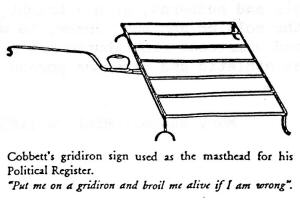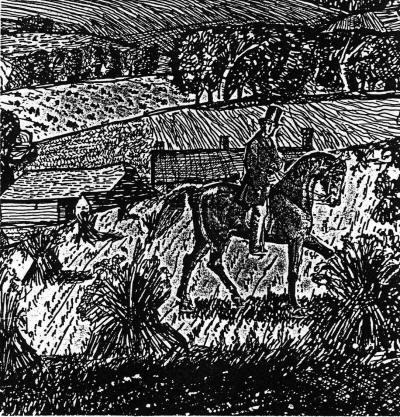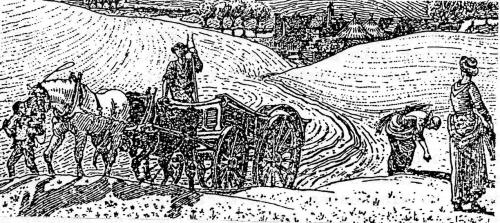No. 102 WILLIAM COBBETT AND ALRESFORD.
by Kenneth S Masters.
"I
saw great Cobbett
riding,
The horseman of the shires;
And his face was red with judgement
And a light of Luddite fires,"
G.K. Chesterton
William Cobbett, the son of a farmer, was born at Farnham in Surrey on 9th March 1763. He was educated by his father and his first known contact with Hampshire was in 1782 when he visited Portsmouth and saw the Channel fleet at anchor in Spithead. As a result of this experience he tried unsuccessfully to become a sailor In 1783 he commenced work as a clerk in Grays Inn, but left the next year to join the 54th Regiment of Foot.
After thirteen months at Chatham the Regiment sailed to Nova Scotia and then on to New Brunswick where Cobbett was to stay until 1791. During this time he rose from the rank of Corporal to that of Sergeant Major to which he was promoted over the heads of thirty Sergeants. His Commanding Officer later thought sufficiently highly of him to recommend him for a commission. Cobbett was by this time engaged in collecting evidence to expose the Quartermaster or the regiment who had been keeping back provisions due to the men. On his return to England he refused a commission, resigned from the army and informed the Secretary of War about the case. A Court Martial was arranged but in the interim Cobbett married, in 1792, Ann Reid, the daughter of a Sergeant of Artillery whom he had met in Canada.
Cobbett then appears to have had second thoughts about his case against the Quartermaster and he left England for France in March 1792, a month after his marriage. The Quartermaster and two other officers were acquitted due to the non-appearance of Cobbett. A year later, worried by the deposition of King Louis XVI from the French throne, Cobbett and his wife sailed to America and settled near Philadelphia which at that time was the capital. There he taught English to French emigres. He wrote an English grammar, the first or many books, and this was followed by a Political Pamphlet in 1794 Thus started Cobbett's career as a Political Writer and Commentator.
 In
1799 Cobbett returned
to England following
an unsuccessful lawsuit
against a patent medicine
manufacturer who was
awarded $5.300 damages.
In 1802 he founded an
independent journal the
Political Register and
three years later bought
a farm at Botley between
Portsmouth and Southampton.
He owned this farm until
1820 and
during this period continued
his
political writing.
He spent from 1810 -
1812 in Newgate
Prison following his
trial and conviction
on a charge of sedition.
In 1817 the Habeas Corpus
Act was suspended and
Cobbett, fearing that
he might be imprisoned
again, returned to America
until 1819, although
his wife stayed at Botley.
Although he spent considerable
periods away from Botley
his later writings show
that he had enjoyed,
his period of being a
farmer and it was only
his bankruptcy which
forced him to sell in
1820.
In
1799 Cobbett returned
to England following
an unsuccessful lawsuit
against a patent medicine
manufacturer who was
awarded $5.300 damages.
In 1802 he founded an
independent journal the
Political Register and
three years later bought
a farm at Botley between
Portsmouth and Southampton.
He owned this farm until
1820 and
during this period continued
his
political writing.
He spent from 1810 -
1812 in Newgate
Prison following his
trial and conviction
on a charge of sedition.
In 1817 the Habeas Corpus
Act was suspended and
Cobbett, fearing that
he might be imprisoned
again, returned to America
until 1819, although
his wife stayed at Botley.
Although he spent considerable
periods away from Botley
his later writings show
that he had enjoyed,
his period of being a
farmer and it was only
his bankruptcy which
forced him to sell in
1820.
Although his home was to be in future at Kennington on the edge of his abhorred Great Wen as he described London, it consisted of "four acres of rich land for cows and pigs surrounded by nursery gardens". It was from Kennington that he set out on his famous Rural Rides about which he began to write in 1821 and which were published in book form in 1830.
Many of the rides were through the towns and villages, rivers and Hampshire and Cobbett describes streams with a sharpness which gives a vivid impression of what life was like in the years immediately following the Napoleonic Wars. His accounts on the rides also contain his pungent comments on some of the social evils of the times together with many of his own prejudices - paper money - the large number of service pensioners following the War - and the clergy.

"He was a tall, stout man, fair and sunburnt,
with a bright smile, and an air compounded of the soldier and the farmer,
to which his habit of wearing an eternal red waistcoat contributed not a
little. He was, I think, the most athletic and vigorous person that
I have ever known".
Mary Russell Mitford (1852)
Alresford is first mentioned in a ride made in September 1822, although Cobbett chose to avoid the town and rode from Preston Candover where he comments on the avenue of yew trees a mile long, through Ovington to Winchester. At Northington he passed between the two estates or the sons of Francis Baring, the founder of Barings Bank. One of them, Alexander, had enclosed Northington Down and his planting of the down with clumps of unsuitable trees, brings forth the critical comments of Cobbett the countryman.
In November 1822 he was once again riding through Hampshire past Micheldever Woods, East Stratton, Abbotstone to Alresford where he arrived on the evening of the 17th.
"I saw at a village called Stratton, I think it was, the finest campanula that I ever saw in my life. The main stalk was more than four feet high and there were four stalks, none of which was less than three feet high. So that the goldfinches, were got here in flocks, and, as they continued to fly along before me, for nearly half a mile, and still sticking to the roads and banks I do believe I had, at last, a flock of ten thousand flying before me".
He stayed the night in Alresford although we do not know where; in those days there were many more hotels and inns in the town than there are today. The next morning he rode on to Hambledon through Tichborne, Cheriton and Kilmeston.
"...Alresford which is a nice little town of itself, but which presents a singularly beautiful view from the last little hill coming from Abbotstone."
The Tichborne Park fencing caught Cobbett's eye;
"I saw the park pales with sorrow there is not more than one pale in a yard and those that remain and the rails and posts and all seem tumbling down." Cheriton he describes as a "....little hard won village where all seems to be as old as the hills that surround it." At Kilmeston he found what had formerly been a large village but now mouldered into two farms and a few miserable tumble down houses for the labourers. The same passage contains an account or Old Alresford pond, the Itchen valley and of the villages falling into decay through the accursed Pitt-system as Cobbett described the Enclosure Acts and patronage which was rife at that period.
In August 1823 he visited Easton on his way from his former home of Botley. The following day he passed through Itchen Abbas, Itchen Stoke, Alresford and Bishops Sutton, to Selborne.
At Avington Park:
"The turnips, upon this farm, are by no means good: but, I was in some measure compensated by the sight of the Duke's turnip-hoers, about a dozen females, amongst whom were several very pretty girls, and they were as merry as larks. There had been a shower that had brought them into a sort of huddle on the roadside. When I came up to them, they all fixed their eyes upon me, and upon my smiling, they bursted out into laughter, I observed to them that the Duke of Buckingham was a very happy man to have such turnip-hoers."
Cobbett seems to have been attracted to Selborne by reading Gilbert White's Natural History of Selborne and he was one of the few clergymen for whom the author had a good word. Anglican clergy normally attracted severe criticism from Cobbett as he regarded them as part of the system which he opposed, especially in relation to Tithes aid livings held in plurality.
"This lofty land of North Hampshire, the finest beechwood in all England, large sweeping dawns and deep dells, with villages among lofty trees".

On 30th October, 1825, accompanied by his son Richard, Cobbett rode from Farnham to Alresford through Medstead. Here he saw the finest beech wood in all England. He found no room to his liking at Alresford and went on to a favourite haunt, Easton, where he stayed the night. Ten days later he was again in the district riding from Easton to Martyr Worthy. On the 11th November he passed by Avington Park again, commenting on the beauty of the lake and grounds, and on to Petersfield. There is no mention of Alresford on this occasion, as Cobbett made a detour through Bramdean and may have gone from Avington by way of Tichborne. In Bramdean they stopped to feed the horses and whilst in the Inn the Excise man came and "rummaged it all over".
Although Cobbett made several more rides through Hampshire he never seems to have passed through Alresford again. In 1832 he became a Member of Parliament not as might have been expected, for a Southern Constituency, but for Oldham in the first election held after the Reform Bill. He was re-elected in 1835, but died the same year on the 18th June and lies buried in the churchyard at Farnham his birthplace.
To anyone interested in life in Hampshire one hundred and fifty years ago, Cobbett's Rural Rides is a valuable source of information. His writing is remarkably detailed but it is surprising how little has changed in some of the scenes and views he describes providing me with a rich supply of local historical material.
Kenneth S. Masters, March 1969.
Sources and further reading:
William Cobbett - A. Briggs -Oxford University Press 1967
Rural Rides - W. Cobbett (ed G. Woodcock) - Penguin 1967
N.B. Extracts in bold print come from a variety of sources.